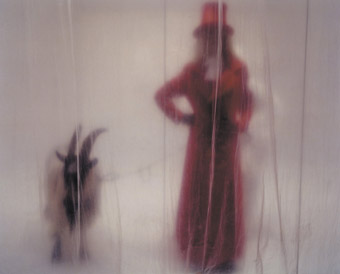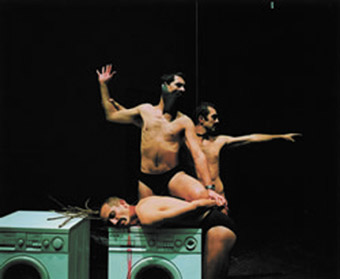Castellucci: theatre of remnants
Max Lyandvert

Tragedia Endogonidia
© Societas Raffaello Sanzio
Tragedia Endogonidia
Romeo Castellucci’s Genesis, From the museum of sleep (Melbourne International Arts Festival, 2002) was the apex and the conclusion of a meta-narrative of theatrical thought from Castellucci’s company, Societas Raffaello Sanzio. In 2001 the company embarked on a major new project, a cycle of 11 episodes/productions called Tragedia Endogonidia, an open system of representation that, like an organism, changes and evolves with time and geography, with the name ‘Episode’ assigned to each phase of its transformation. This system forces a radical re-thinking not only of creation, but also of the whole theatrical system. The aim is to represent a tragedy of the future. The graphic emblem, and one of the aesthetically consistent throughlines of the cycle is a representation of Man and Woman (Adam and Eve), originating from the third planet (Earth), orbiting a star (Sun). This is an image which is being carried by the Voyager space ship launched in the 1970s in search of extra-terrestrial life (and still en route).
The word Endogonidia refers to those beings which are made up of, or have within them, gonads–organs such as the testis or ovary which enable them to reproduce unceasingly. Endogeny implies immortality. Tragedy, to the contrary, involves an inevitable end. The figures living on the stage of Tragedia Endogonidia do not resemble any recognizable myth or history; instead they follow each other in frames that are themselves separate, and the thread joining them is not a narrative, but rather a synchronic memory, where images alternate according to alogical and simultaneous sequencing. Each figure refers to its own frame. No biographies emerge, rather biological instances: fundamental elements consistent to all life, free of context, hierarchy or narrative, addressing questions about humanity in relation to animals, machines and even extra-terrestrials.
These bio-political themes may have been present in Castellucci’s work for a number of years, but in Tragedia Endogonidia they are organised in such a way that the inevitability of any kind of classical tragic narrative becomes impossible. Fragments, images, echoes and remnants can be deciphered, and these are titled and presented to a specific community. The often non-sensical and yet related and familiar way these remnants are organised, both within episodes and as repeated figures throughout the cycle, points to the relationship the episodes have both with each other and with the city which hosts them. In any particular episode then, one will neither be getting the ‘whole thing’ nor a fragment of a totality. It is useful, in this case, to think of a remnant, as “neither the whole… nor a part… but, rather, the non-coincidence of the whole and the part…” (Giorgio Agamben, Remnants of Auschwitz: The Witness and the Archive).
Tragedia Endogonidia has developed over a period of 3 years with a total of 11 episodes in 10 cities, each an interdependent episode but a complete production in itself. Episode names are acronyms of cities and the number of the production in the evolving work. I observed rehearsals of P.#06 (Paris), R.#07 (Rome) and C.#11 (Cesena) for 3 weeks (on 2 separate occasions) in Cesena, and the rehearsals in the theatre in both Paris and Rome.

Tragedia Endogonidia
© Societas Raffaello Sanzio
Tragedia Endogonidia
Tragedia Endogonidia begins with fragmented images and metaphors based on sequences and patterns from the chemical and biological elements of life on Earth. While the vocabulary of the score and the scenography is structurally determined by the movement of sperm and the growth of fundamental elements and minerals, the random patterns of the behaviour of a goat (the derivation of the name of tragedy) determines the linguistic properties of the work. Tragedia Endogonidia connects with each city where the work is presented, the focus being on the tragic remnants of the community’s relationship with life on Earth, and even the possibilities of a future on a new world. Consciously or not, the episodes reveal the various stages of their evolution within the cycle, including the influences of the cities which host them. Likewise the actions, props and other objects which form the vocabulary of the cycle evolve and mutate as they reappear in numerous episodes. Like letters in an alphabet, they can be arranged to make sense or not, but they always belong.
In Cesena and Avignon there is a gold box, a child, blood and milk, core elements. In Berlin, the front rows of the auditorium are filled with life-size rabbits, and the stage 3-dimensionally transformed from black to white. In Brussels, the space is a marble cube with fluorescent lights, where the head of a robot tirelessly recites the letters of the alphabet to a newborn baby, to begin the show. In Paris, Carravaggio’s Sacrifice of Isaac is recreated over 2 washing machines; Jesus breaks into the space (which by now has become a kind of museum) through a window; and 2 cars are dropped from the ceiling. In Rome, there is again a cube room–the same as in Brussels–but this time white and, instead of a baby, a chimpanzee. Here Catholic priests force the confession of Mussolini, and while they play basketball, the whole set comes apart and is flown off as an Italian clown breaks into the theatre through the floor. In Strasbourg, the back of the stage is left open, exposing the real European Parliament; a group of actors arrive by bus and watch Hitchcock’s Psycho; and a tank drives into the theatre through the exposed back stage. In London, a variety of spectacular stage transformations and extraordinary figures includes scores of cats, while in Marseilles there are 2 parts at 2 separate theatres. One is a strange representation of a banquet as a photographic still life with extreme stage mechanics representing the photographic revolution, while the other is a sensational sequence of huge screens with macro-projections, a refined music score and opera singer performing towards the end.
The final episode, C.#11, back at the company’s home town is also made up of 2 parts, but in the same building. One is a bedroom with a cleaner, a boy, a cat, 7 men dressed in 1940s suits (including Castellucci himself) and a solid flat which descends and blocks the action to the point where only the feet are visible and pre-recorded voices heard. The audience is then led to the second, larger space veiled by a screen onto which a film of sperm is projected. The raised screen reveals a huge, real forest. Men with torches (very little is visible) find and appear to behead a boy who has been hiding from them, but then present the head of a cat.
These extraordinary stage events are not effects, they are all mechanically real, there is no scenic art. The connection to the city, which gives each episode its name, is obscure or subtle or vague, often no more than a passing image which signifies a specific event or characteristic.
The theatrical and representational essence of Tragedia Endogonidia is the possibility, the impossibility and the inevitability of language. This is a theatre which–acknowledging the relativity of past, present and future–exists within a history which is before, within and outside culture and mythology. By portraying extreme and confronting remains of cultural representations, Romeo Castellucci’s theatre allows for extraordinary juxtapositions and can have a profound and emotional effect. Collectively and individually, the audience possesses conditioned and developed reactions to images and ideas which, in some way, quote or distort cultural references. The core of the distortion is the clash of sacred and profane, cerebral and banal.
The burning images and breathless atmospheres in Castelluci’s creations are inspired by fundamental and original cultural references (drawing on biblical, Renaissance and contemporary iconography), meticulously rehearsed and then re-arranged in a multitude of ways, until ultimate potency has been reached. Therefore the ‘real’ work of rehearsal is not developing the theatrical ideas and images for meaning and interpretation, but rather working and tuning the representation of these ideas to have the maximum sensory, emotional and physical effect on the audience. The arresting power of the imagery and the sound of Castelluci’s theatre invites rich psycho-emotional reaction, happily bypassing rationalism, plunging the viewer into a space which is at once foreign and familiar, a space which is a type of core, a fundamental where the intellect and the senses are neutralised.
RealTime issue #66 April-May 2005 pg. 37






